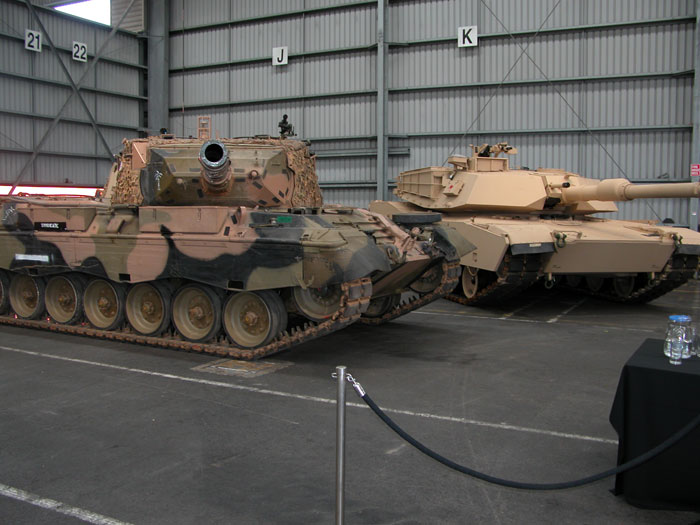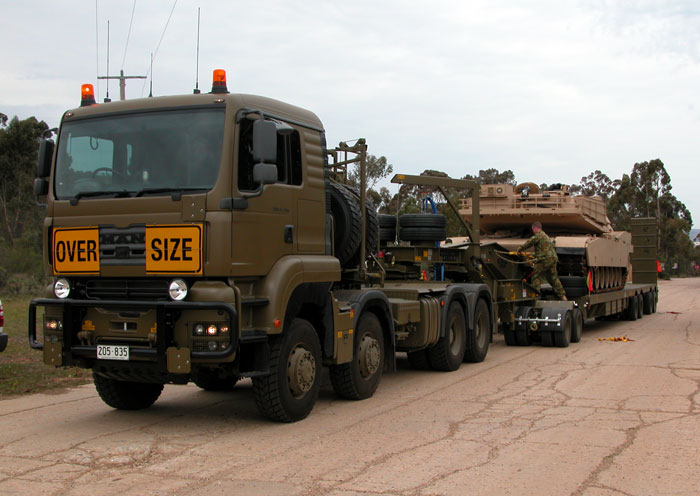|
The Australian
|
|
|
|
The Abrams named Chauvel on the dock in Melbourne. |
by Paul D. Handel
![]()
Introduction
On Thursday, 21 September 2006, the first of the Australian Army’s new M1A1 Abrams Main Battle Tanks and M88A2 Hercules Armoured Recovery Vehicles arrived in Melbourne. This was the result of a Government decision to replace the Leopard AS1 Main Battle Tank, which had been in service since 1977, with an off-the-shelf buy of current in-service tanks.
A number of different tanks were considered for the Leopard replacement, including Leopard 2 and Challenger 2, but the overall deal by the US Government for the Abrams was the biggest factor in sealing the deal. The supply of tanks, recovery vehicles, logistic and training support was something which the Australian Government could not go past.
|
|
|
The old and the new. A Leopard AS1 stands alongside an Abrams during the arrival ceremony in Melbourne. |
The Abrams has a survivability on the battlefield second to none. It has the commensurate firepower and mobility to provide the key component in the combined arms team. It is battle-proven and is currently one of the main combat vehicles of US forces in Iraq.
![]()
The M1A1 AIM SA Abrams
The M1A1 Abrams Integrated Management Situational Awareness Main Battle Tank traces its origins back to February 1976, when Chrysler Corporation handed over the prototypes to the US Army for testing, alongside prototypes built by Detroit Diesel Division of the General Motors Corporation. In November of 1976 the Chrysler tank was announced the winner. Production commenced in 1979 at the Lima tank plant, with the first production M1 Abrams tanks ready in 1980.
From the beginning, the M1 was fitted with Chobham armour, thermal imaging sights and electronic gun control systems and a turbine engine. Initially equipped with a 105mm gun, the later M1A1 mounted the M256 120mm smoothbore gun.
The M1A1 AIM tank is a fully rebuilt vehicle, undergoing a complete disassembly where each component is checked and then rebuilt or replaced. A zero miles as new tank is then provided back to the US Army. The Australian Abrams tanks are from this programme.
Australia has purchased 59 Abrams tanks.
![]()
Tank Details
Weight Combat Loaded: 63,500 Kg
Length (Gun Forward): 9830 mm
Turret Height: 2438 mm
Width: 3658 mm
Ground Clearance: 483 mm
Main Armament: 120 mm M256 Smooth Bore Cannon
Coaxial Weapon: 7.62 mm MAG58 Machine Gun
Loader's Weapon: 7.62 mm MAG58 Machine Gun
Commander's Weapon: 12.7mm M2HB QCB Machine Gun
Smoke Grenade System: 66mm Launcher Grenade M250
Fuel type: Multi-fuel. Australian tanks will use diesel.
Power Plant: Gas Turbine Engine: 1119 kW
External Auxiliary Power Unit: Single cylinder, air cooled diesel engine.
Governed Speed: 66.8 kph, Cross-Country: 48.3 kph
Crew: 4 (Commander, Gunner, Loader, Driver).
![]()
M88A2 Hercules Heavy Recovery Vehicle
The M88A2 recovery vehicle first saw combat in South Vietnam as the M88. Although the vehicle is not based on the M1A1 MBT, it is the only vehicle in the US inventory able to recover the Abrams tank. In the US Army HERCULES stands for Heavy Equipment Recovery Combat Utility Lift and Evacuation System.
|
|
|
An M88A2 Hercules recovery vehicle with boom raised. The red kangaroo is positioned under the Army Registered Number. |
The M88A2 is substantially upgraded from the early M88, having an improved and uprated diesel engine, new larger capacity winches and boom, and added armour protection. It is believed that the seven M88A2s acquired by Australia are brand-new vehicles.
The M88A2 Heavy Recovery Vehicle is an armoured, full tracked vehicle used for hoisting, winching, and towing operations.
Weight Combat Loaded: 63,699 Kg
Length: 8640 mm
Height: 2970 mm
Width: 3660 mm
Armament: 12.7mm M2HB QCB Machine Gun
Smoke Grenade System: 66mm Launcher Grenade M239
Power Plant Diesel Engine: 783 kW, 12 cylinder, 4 cycle, air cooled.
Auxiliary Power Unit: 13 kW, 2 cylinder, 4 cycle, air cooled.
Maximum Speed (without towed load): 48.3 kph
Crew 3 (Commander, Driver and Rigger).
![]()
Camouflage and Markings
The Abrams and Hercules are painted in the standard US factory finish sand colour, and carry the red kangaroo on the turret sides (Tank) and hull superstructure sides (M88A2).
The tanks carry Army Registration Numbers (ARN) in the 2070** range, whilst the Hercules have ARNs in the 20710* range.
Other markings at this stage are limited to various lifting and/or towing points. One tank was named “Chauvel”, in honour of General Sir Harry Chauvel, a legend if the Australian Lighthorse, the predecessors of today’s Royal Australian Armoured Corps.
At least one M88A2 bears a name in black at the top of the hull superstructure.
![]()
Heavy Equipment Transporter
To carry the heavier vehicles it was originally thought that the M1070 Oshkosh HET would be acquired. However, it is understood these vehicles did not met Australian Design Rules for vehicles and so a locally sourced tank transporter was purchased.
This was the MAN TGA 8x8 prime mover with a 530 hp diesel engine, a ZF automatic gearbox and a military specification cooling system. An air-conditioning unit and sleeper cab are provided for crew comfort. The trailer was designed and built by Drake Trailers of Brisbane, and is an expanding deck trailer with a dolly converter. The trailer deck can be expanded from 2.5 to 4.27 metres wide.
|
|
|
A front view of the MAN 8x8 tractor and Drake trailer, with the first Abrams to arrive in Puckapunyal. |
The prime mover and trailer, when fully loaded to a maximum gross vehicle mass of 107 tonnes, can travel at 90 km/hr.
Fourteen vehicles were initially purchased with another four being recently ordered.
![]()
Conclusion
These state-of-the-art vehicles will allow the Australian Army to maintain its tank capability, and will ensure inter-operability with our closest ally.
The Abrams and Hercules will equip the Army’s only tank unit, the 1st Armoured Regiment, located in Darwin. Vehicles for training purposes will be held by the School of Armour, Puckapunyal and the Army Logistic training Centre at Bandiana.
![]()
The Australian M1A1 Abrams Photo Album
Click
the thumbnails in the table below to view the images full size.
Use your browser's "back" arrow to return to this page.
![]()
Article Text Copyright ©
2007 by Paul D.
Handel
Page Created 25 April, 2007
Last Updated 24 April, 2007
Back to Anzac Steel Main Page











